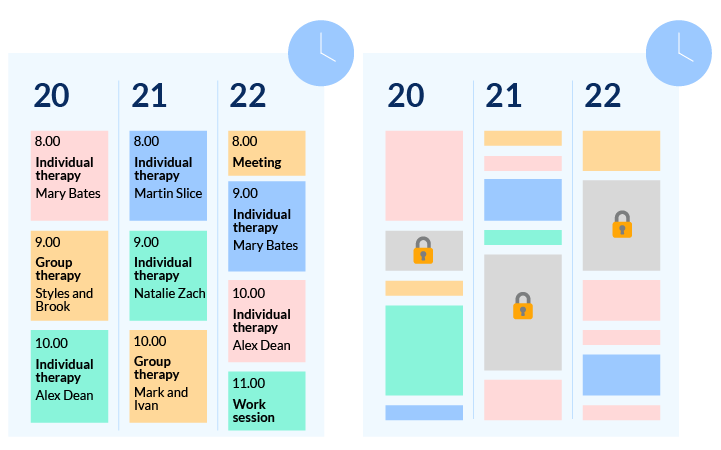Premature termination of therapy is a significant yet often neglected problem that leads to severe consequences for clients and psychologists alike. According to some estimates, 20% of adult clients end their therapy abruptly. Unfortunately, even experienced practitioners using the best evidence-based techniques cannot successfully promote positive, long-term change in clients who do not complete the full course of treatment.

Sometimes, a client’s dropping out of therapy is related to the therapist; other times, it’s related to the client; and sometimes, it’s the result of a combination of factors from both parties. In this blog post, we reveal the most common reasons why clients stop therapy suddenly and provide tips on fighting no-shows and increasing client retention.
The most common reasons why clients stop therapy suddenly
Premature termination of therapy is a challenge for every psychologist. It’s impossible to avoid this risk completely; however, being aware of some prominent reasons clients miss their sessions should help you develop a strategy to reduce no-shows and consequent dropouts.
Here are the most common reasons why clients drop off, along with recommendations on what you can do to retain your clients.
1. Administrative issues
One of the easiest to detect and easiest to solve reasons why clients don’t come back is how you organize your sessions. Everything matters, starting from comprehensive and user-friendly booking and automated reminders to short waiting times and good session time management. You risk losing your clients every time they have to go through back-and-forth communication by phone or email, wait till you finish the previous session, or leave their own session late.
Possible solutions to administrative issues
Bad session time discipline harms clients who are waiting for their sessions. It’s tempting to develop a discussion over last-minute revelations or breakthroughs; however, you need to keep your timing strict. You’re encouraging your clients to miss future sessions by not respecting their time. So make sure to use last-minute breakthroughs as a topic for your next sessions and to finish your meetings on time. In case you can’t guarantee that, introduce a 10- to 15-minute buffer between your sessions. Show respect for your clients’ time, and your clients will respect yours in turn.

Pro tip: Develop the habit of blocking out buffer time after each session to give you time to decompress and take a break.
Additionally, a special software system can reduce missed appointments by 25%. Clients are more likely to come back if it’s easy to do. And it’s much easier to book a session online without having to talk to a person. Comfortable booking and reminder software dispels excuses for not starting sessions due to a complicated booking process and drastically decreases appointment no-shows.

For instance, ExpertBox is HIPAA-compliant software that lets you streamline patient care delivery. ExpertBox offers online scheduling and booking, an automated reminder system, chat-based messaging, and secure billing and invoicing to build long-term client relationships.
2. Logistics issues
Clients commonly have problems getting to the office or finding childcare. Such hurdles can have a cumulative effect and lead to ending therapy abruptly, no matter how much your clients want to solve their issues. Besides, most clients have a lot of responsibilities such as full-time jobs, families with young children, and social calendars. Often, you can’t prevent logistics issues, but you can mitigate them and make your sessions more pleasant for your clients.
Possible solutions to logistics issues
The first recommendation on how to keep your clients coming back is to analyze patterns of missed appointments. When you see patterns, never offer a client the time slots they have a high likelihood of missing. Talk to your clients as soon as possible when you notice that they’ve started developing a tendency. Besides that, you can offer extended or weekend hours to avoid rush hour traffic. You may also offer sitter services in your office to help clients with children visit your sessions comfortably.
Second, you can offer to have your sessions via video. Due to the COVID-19 outbreak, this has become a very popular way of conducting therapy sessions. You can offer video either as an occasional substitute for on-site visits or adopt online therapy on an ongoing basis. All you need is trustworthy HIPAA-compliant software, a computer, and a stable internet connection. Your clients can use any device (a smartphone, tablet, laptop, or desktop computer), an internet connection, and a comfortable place to spend an hour with you.

HD video meetings via ExpertBox can help you solve this issue, keep a cozy one-on-one atmosphere in your sessions, and keep your clients coming back. The software’s plain interface, personal video meeting rooms, screen sharing, and cloud recording make ExpertBox an indispensable instrument in your therapy routine.
Find your perfect video call software to deliver the best experience to your clients in our article: Comparative Review of the 10 Best Video Conferencing Software Solutions for Online Consulting with Clients in 2021.
3. Issues with irrelevant treatment and misdiagnosis
To have successful sessions and treat a client effectively, a psychologist needs to find the root cause of the client’s issue, develop a clear and accurate diagnosis, and create a suitable treatment plan. Unfortunately, mental health specialists are prone to misdiagnose.

In addition to bipolar disorder, other frequently misdiagnosed mental health disorders include depression, borderline personality disorder, ADHD, PTSD, and anxiety.
Obviously, the effects of mental health misdiagnosis are dangerous both for clients and their social circles. Misdiagnosis keeps people from receiving treatment for their actual issues, increases stress, and demotivates clients.
A possible solution to diagnosis issues
Remember that the day your clients get the right diagnosis is the day they start to heal. Diagnostic clarity is essential to ensuring effective treatment. To achieve that, provide the time and space for an accurate diagnosis, a formal psychological assessment, and ongoing monitoring to observe evolving symptoms and responses to treatment.
4. Financial issues
This is perhaps the number one reason for clients ending therapy abruptly. A relationship with a psychologist requires devotion and investment in the form of time and money. If any of these components is absent, clients will inevitably stop therapy suddenly.
If your client doesn’t show up after receiving an invoice, it may be that they simply cannot afford to pay the balance or are too embarrassed to discuss payment options with you. If a patient has to choose between a therapy session or paying the bills, they are unlikely to continue their care.
Secondly, clients may have insurance that doesn’t cover mental health treatment. They may realize that even if they start paying out of pocket, they won’t be able to pay for all of the necessary sessions.
Possible solutions to financial issues
A payment plan might be a viable option if your clients are unable to see you due to financial constraints. Reach out and offer this option. Another option is to provide mental health financial assistance through a sliding scale-based payment system. In this way, you provide your clients the power to manage their finances and therapy by coming to an agreement that works for them.
We also recommend studying insurance packages that cover your services and offering a list to your clients so they can see the options available.
Besides that, you can recommend that your clients look into a medical credit card to cover expenses like mental health and healthcare out of pocket.
Remember that you can’t push your clients to take on debt or manage their finances, but you can show options if they are interested in continuing treatment.
5. Comfort during sessions
A client’s physical and psychological comfort are of the utmost importance. The design of your office should be calming and congenial, the colors soothing, the armchairs comfortable and relaxing, and the light natural and low. You can find inspiring design ideas on websites like Pinterest.
Pro tip:If your workplace is well-designed, it can assist you in providing care in ways that benefit your clients.
While you can consult an interior designer regarding your office design, a designer can’t craft the way you behave with your clients and how you make them feel. Sometimes, misunderstandings or even conflicts may occur due to the emotional nature of therapy-related issues. If it turns out that any of your words or actions make a client feel uncomfortable, detached, or disrespected, it might influence their decision to attend your sessions.
A possible solution to issues of comfort
Be conscious of your personal biases that may be apparent during a session if your client’s lifestyle choices are incompatible with your principles. Be aware of subtle, unconscious reactions to shocking, disturbing revelations of your clients that may provoke your reactions. These are standard principles of conduct for psychologists; however, it’s important to remember them because they can influence your client retention rate.
Also, remember that sometimes it’s best to let a client go and recommend another psychologist if you feel tension and don’t click.
6. Client’s personal concerns
Even though a client has found the courage to come and see you, they still might be too embarrassed to open up. It’s common that clients don’t want to get in touch with their emotions because they’re afraid of judgment.
Others might be skeptical and suspicious of the efficacy of treatment for different reasons — a previous experience with ineffective therapy, a feeling that it’s too difficult for them. When clients don’t understand the need for ongoing help or how their treatment is providing benefits, they are more likely to stop therapy suddenly.
Another reason for ending therapy abruptly is that clients have unrealistic expectations or are deluded by the favorable quick effect of the therapy. After a couple of sessions, they might expect to have their issues solved and become overwhelmed by the positive changes as the symptoms fade and they feel better. However, the journey has only started, and stopping therapy too soon can backfire.
Possible solutions to personal concerns
First, your task as a psychologist is to create a welcoming atmosphere, educate clients on how therapy works, and win your clients’ trust. When clients don’t return, it’s usually not because you’ve done or said something wrong but because of the feeling clients get about what they’ve done. Unfortunately, there’s not much you can do if your clients miss sessions due to a fossilized feeling of being hurt, ill-cared for, or judged by everyone around. Sometimes, the only thing you can do is be attentive to verbal and nonverbal cues from clients, establish trust, and ensure that clients realize you’re there to help them, not to condemn or judge them.
To avoid unrealistic expectations from your sessions, the first thing you should do from the start is to set a clear treatment plan with goals and expectations and course correct as needed. If you provide your clients with end dates and clear goals to achieve, they’ll be motivated to continue with their courses of treatment or speak up about ending therapy early. Besides that, explain to clients why it’s important to stay the course, tell what may happen if they leave prematurely, highlight their role in the process, and be open to questions.
7. Professional issues
If you have a new private psychology practice or are just starting off in your career, your clients might leave just because they see you don’t have enough expertise to help them. Don’t panic. This is a widespread issue, and you’re not alone.

A possible solution to professional issues
When starting a career as a psychologist, you should embrace any opportunity to help your clients and be grateful for the clients who are willing to stay. The best option is to continue to work diligently with your current clients, upgrade your skills, and ask for feedback.
8. Natural causes
When a client finally reaches the end of their journey with you, it’s time to celebrate another professional victory. However, there is another side of the coin — it’s time to say goodbye, and there is nothing you can do. Or is it?
A possible solution
You may still be able to continue sessions with your client to solve another issue they might have. After successful treatment, you might unveil potential new areas to tackle. For example, a client may find that family therapy sessions are just what they need.
Pro tip: Encourage your clients to explore the different services that you provide, as long as you think that it will help them.
Summing up
It’s demotivating when a client ends therapy abruptly. However, there is nothing wrong with that, as every practitioner faces such a situation at least once. The best you can do is to identify patterns of clients ending therapy, determine the causes, and find solutions. Following the tips we have shared may improve your client retention rate. In the meantime, subscribe to our newsletter to get more tips on improving your services and marketing your private practice.




